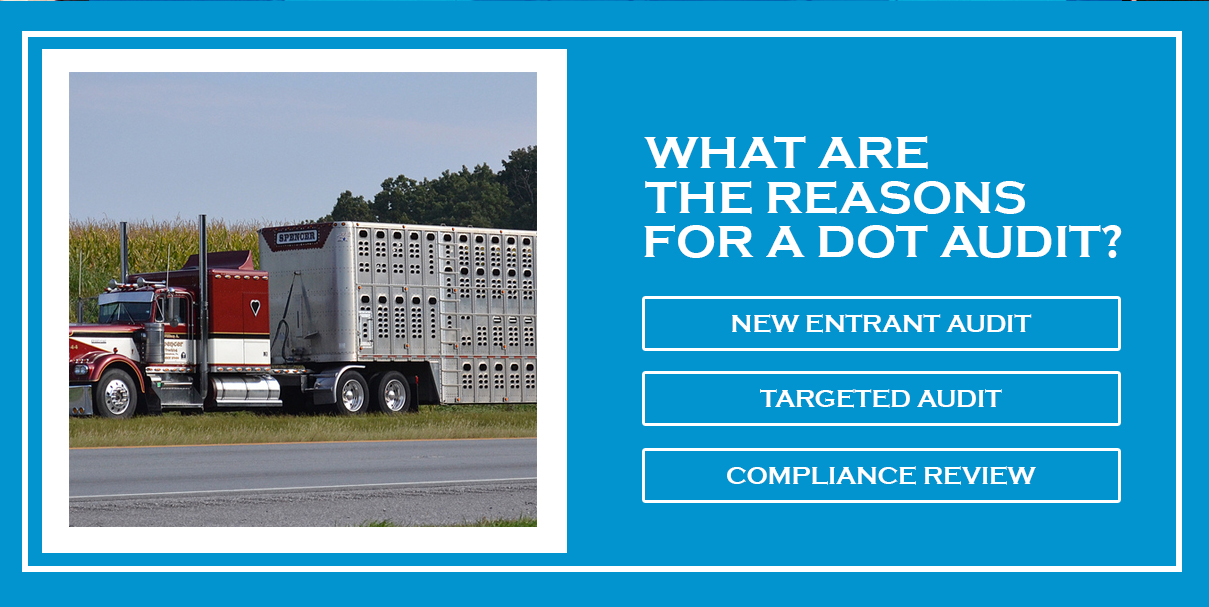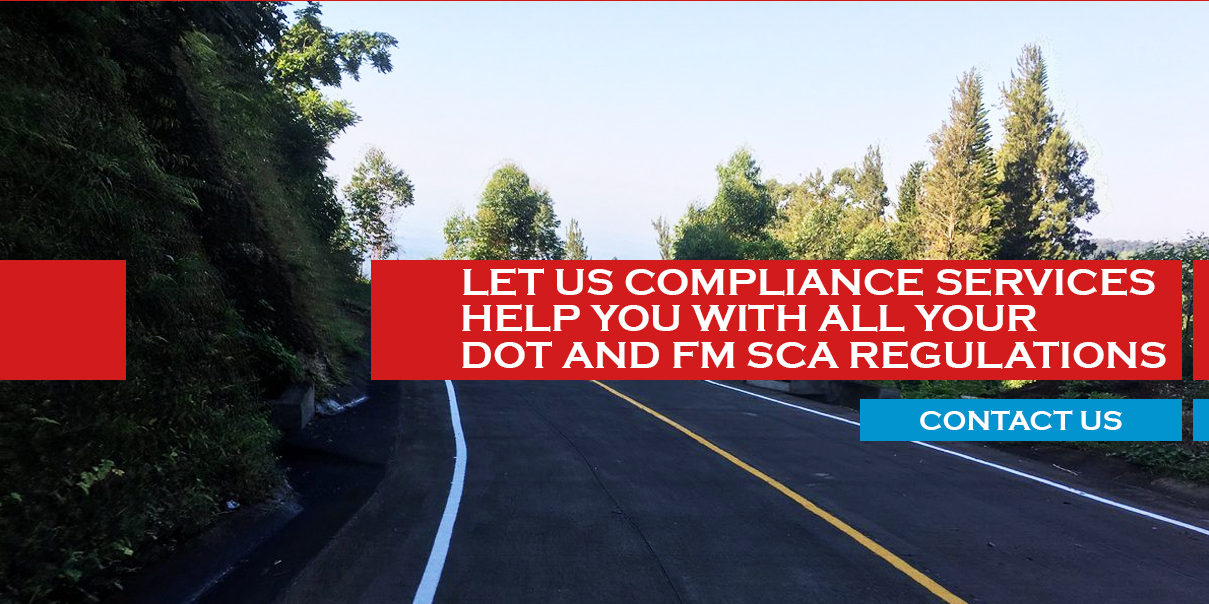Preparing for a Trucking DOT Audit

Knowing that you are about to face a federal Department of Transportation (DOT) audit on your commercial motor vehicle (CMV) business is always alarming. Even if you’ve been maintaining your records and following all the rules and regulations required, it’s human nature to feel wary and nervous beforehand.
Since DOT gives very little notice of an upcoming audit, it’s perfectly natural to feel anxious. However, DOT conducts audits on a regular basis. They need to make sure all CMVs are following regulations.
If you think these audits have increased over the past few years, you’re right. Audits have increased since 2010, primarily due to the introduction of the Safety Measurement System. It depends upon the data collected from roadside inspections and way stations. Each carrier is then assigned a Compliance, Safety and Accountability (CSA) score and companies with a high score and lots of violations can count on being audited.
Always keep an eye on your CSA score. If you’re noticing the score is creeping up, make changes before you get audited. You can see your score on the Federal Motor Carrier’s Safety Administration’s (FMCSA) Safety Measurement System website. It’s updated every month.
What Are the Reasons for a DOT Audit?
Many people who don’t work specifically in the trucking business are somewhat taken aback when they receive notice of a DOT audit. But if you work in construction or manufacturing, you likely operate CMVs as part of your business.
Regardless of your field of work, if your business involves moving property or passengers as part of interstate commerce, and those vehicles have a gross vehicle weight rating (GVWR) in excess of 10,000 pounds, you, your employees and those vehicles fall under FMCSA regulations.
If your company operates intrastate, only state regulations apply. It’s best to check with your state’s Department of Transportation to find out the regulations and guidelines that govern your area.
The reasons for a DOT audit fall into several categories:
- New Entrant Audit
A new entrant audit occurs during the company’s first 18 months in business, although it usually happens within the company’s first six months after DOT has assigned your business a number. DOT designed this audit to make sure you’re off on the right foot, and you’re complying with all the correct registrations.You may also get a new entrant audit if you have made significant changes to your business. For example, if you have been involved in intrastate commerce for many years and decide to go interstate, you would then be subject to a new entrant audit regardless of how many years you had been in business. - Targeted Audit
You will be the subject of a targeted audit if your CSA score is high. Two or more alerts will put you on a DOT-monitored list. Any additional alerts will almost guarantee an audit. - Compliance Review
Before DOT does a compliance review, they will contact you by phone a week or two before they arrive to do the actual audit. Several different factors can trigger a compliance review:- Crash rate: The DOT acceptable crash rate is 1.5 crashes per million miles driven. If your drivers have a higher ratio than that, DOT may initiate a compliance review.
- Citizen’s complaints: While that is true that the occasional citizen will complain to DOT about the way a driver has passed them on the road or cut them off in traffic, most of these complaints come from disgruntled employees. Very often they base these complaints on areas where they think you will have a difficult time defending yourself.
- Critical crash: If any of your drivers are involved in a crash that results in a fatality or is extremely high-profile, it will trigger a compliance review. For instance, a truck that overturns, spills its entire cargo across an interstate highway and blocks traffic in one or both directions for hours — something sure to be on the news — will likely cause a review.
- Random selection: Sometimes you will get a call from DOT saying it’s your time for a compliance review. It’s purely the luck of the draw.
What Is Reviewed During a DOT Audit?
When DOT audits a commercial motor vehicle company, that audit will generally cover several important areas:
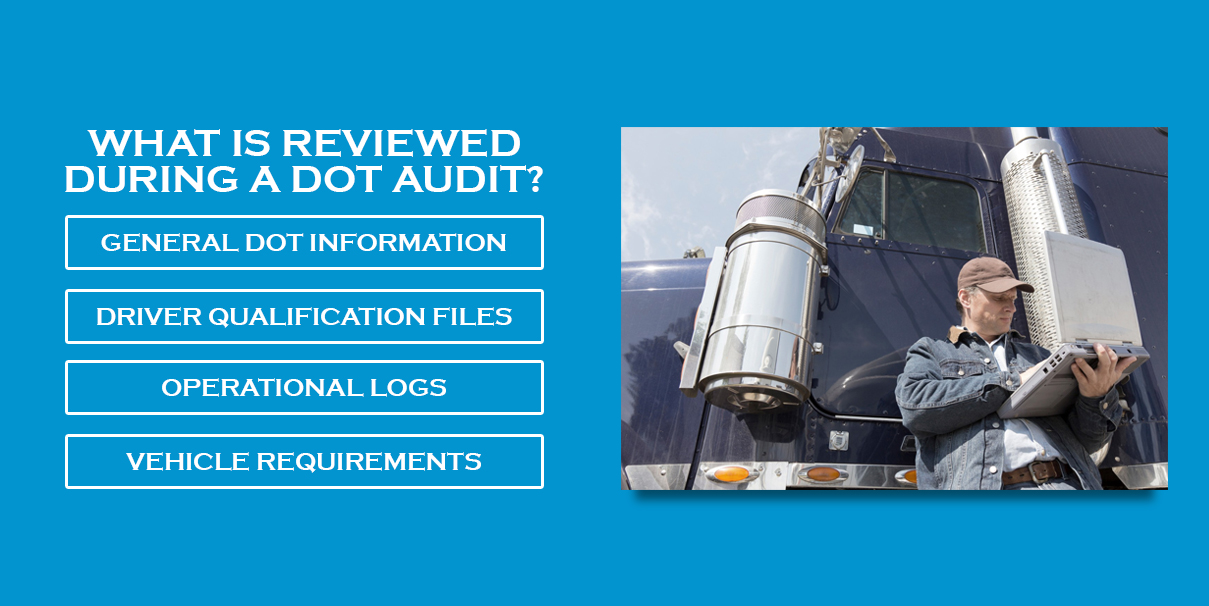
- General DOT Information
You must provide evidence and documentation of insurance for all your vehicles and the kind of cargo that the vehicles are transporting. This means you should prepare all proper forms, such as the MCS-90, for inspection.The DOT auditor will also want to see your company’s accident register. The primary purpose for DOT to inspect this register is to make sure that you are maintaining accurate records of any accidents involving your company. It’s important to know that even if you have the world’s greatest drivers and you don’t have any accidents, you still need to have the register ready for review. And if one of your vehicles has been involved in a crash that falls under the definition of “an accident” according to the FMCSR, you must maintain a record of that accident in the register for three years from the date when it occurred.DOT will also review training records. Remember, the FMCSR requires you train not only your drivers but anyone who works for you who is involved in complying with regulations too. DOT may also inspect your vehicle markings to ensure your CMVs are marked on at least two sides with your legal or tradename and the number assigned by DOT, clearly marked as a DOT number. - Driver Qualification Files
This section of the review covers licenses, qualifications and testing for drugs and alcohol. You need to show DOT that all your drivers have the correct licenses for the class of vehicle they drive and hold the appropriate endorsements.It is vital that you have a drug and alcohol testing program in place and a written policy that describes the program. You need to show that the program is written and presented to all drivers, and you should have a signed receipt from each one of them available for inspection.One of the fastest ways that you can find yourself with an unsatisfactory mark after an audit is to neglect your drug and alcohol testing program.If a driver has been with you only a short time, you need to prove that you have tried to obtain three years’ worth of drug and alcohol testing information from their previous employers. This is not always possible, but you need to show that you made an appropriate attempt.If one of your employees has an alcohol or drug problem, and you decided not to fire them but to help them with rehabilitation, you must show documentation about their treatment, the completion of a program, when they returned driving and any follow-up tests you have done. - Operational Logs
Anyone operating a CMV needs to follow all the regulations about driving limitations and hours of service. When the DOT auditor arrives, they will need to see at least six months of driver logs and documents that support the logs. You are required to maintain an electronic or a paper file for each driver.Driver logs should contain four basic statuses:- Off-duty: The driver isn’t working
- On duty: The driver is working but not driving. This includes things such as refueling and loading freight.
- Sleeper berth: The driver isn’t working but isn’t quite off-duty while resting in the sleeping area of a vehicle.
- Driving: The driver is operating the vehicle.Drivers can face serious consequences if they violate the hours of service rules. These rules regulate how many hours a driver can work and when they need to take breaks. A driver can’t drive more than 11 hours in one day, they must take a 30-minute break every eight hours and a 10-hour break every 14 hours, and they can’t work more than 70 hours total in an eight-day period.
- Vehicle Requirements
Any CMV in your possession for more than 30 consecutive days must be enrolled in a maintenance program that includes regular inspection and repairs. The auditor will expect to see all relevant records that prove this.Every vehicle that is part of your fleet requires a maintenance file. The file should also have the license plate number, the year and the model of the vehicle, its VIN, the engine’s serial number and the size of the tires on the vehicle. You must maintain these records for at least a year.If more than 34 percent of your vehicles are out of service at any one time, chances are you will only get a conditional pass. Most companies aim for around 20 percent. The same is true if more than 10 to 12 percent of your drivers are also unavailable. Try not to go higher than five percent.
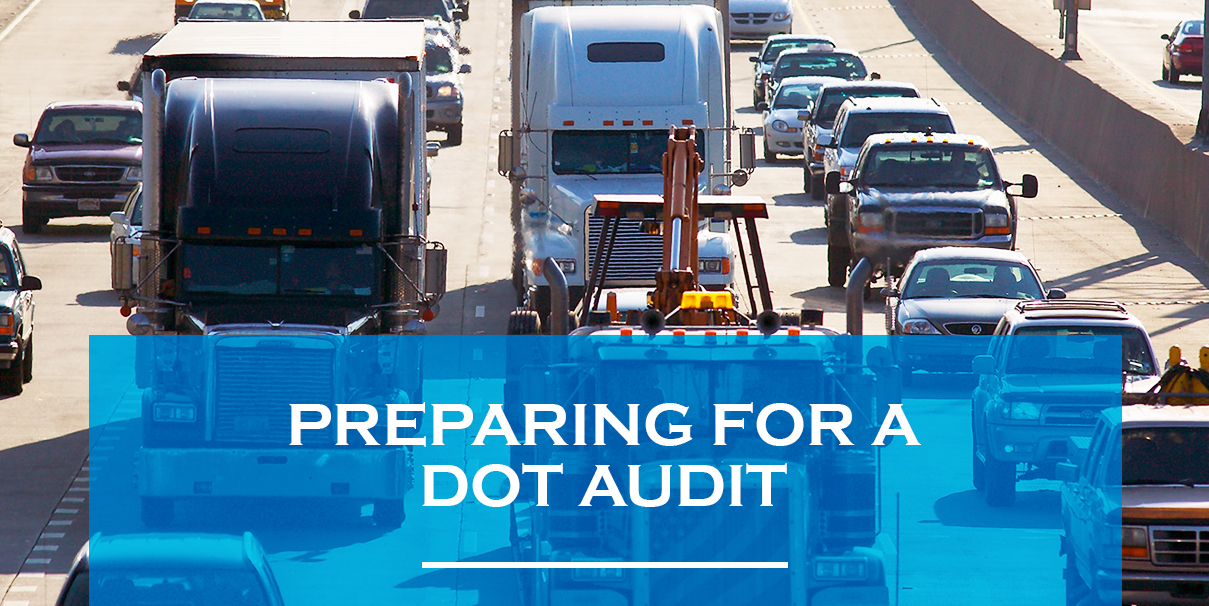
Preparing for a DOT Audit
The key factor in a DOT audit is preparation, and the best way to prepare is to maintain all documentation consistently. For instance, keep all important DOT information in the correct order for an audit on the right side of the folder and all the non-DOT information on the left side of the folder. This works for drivers or vehicles. That way, when the auditor arrives, you simply need to remove all the files on the right side of the folder. Also, if you know you’re going to need to get files ready, do not wait until the last second. The moment you receive notice of the audit, assign several team members to prepare the relevant documents. There is nothing worse than spending 30 to 40 minutes finding a piece of information for an auditor.
Speaking of the auditor, remember that they are not your friend. It doesn’t matter how chatty they are or how amiable they seem — they are not there to do you a favor. For that reason, when the auditor arrives, put them in a private room away from the general flow of business. Don’t give them access to your drivers or anyone else who works for you. Either you or a person you designated should remain with them as a point of contact throughout the entire audit. Don’t give them any more information than is legally required. Any files you present should have a minimal amount of information — no more and no less.
We can’t stress enough how important it is to be prepared. It may seem like a hassle — especially if your company isn’t specifically a trucking company but operates trucks to transport property across interstate lines — but it will make your life a lot easier. And when you’re taking part in an audit, listen and ask questions. Before an auditor leaves the closeout meeting, make sure you understand what will be in the final report and challenge some of their findings if necessary.
What Happens During a DOT Audit?
During the audit, auditors look for patterns and consistency in violations, abuse or ongoing safety issues such as speeding or traffic stops. They primarily find this information through many different pieces of documentation, so it’s important you know what to expect and how to prepare for a trucking DOT audit.
Below are lists of items to look through to make sure you pass the DOT audit. Auditors will request documentation and information from three primary categories — drivers, vehicles and the carrier. It’s important to address each item within these categories to avoid an audit failure and meet the requirements to protect the future of your business.
Drivers
The auditor will need to collect extensive information about your drivers. Here are the items you need to gather:
- Driver’s list: Provide information about your drivers, including their names, date of hire, license number and date of birth.
- Driver’s licenses: All drivers must provide an active commercial driver’s license (CDL) or operator’s license. Note of any driver exemptions.
- Records of duty (ROD): Provide the hours of service (HOS) tracking and other supporting documentation.
- Motor vehicle records (MVR): You must ask your drivers for their MVR every 12 months and keep them on record for three years.
- Driver’s safety performance history: If possible, you should produce records for the last three years.
- Certificate of violations: You must provide documentation of any moving violations for each driver within the last 12 months.
- Medical certificate: All drivers need to show documentation and any applicable waivers for a physical from a certified medical examiner every two years while employed.
- Application for employment: This document shows accident and work history, the employee’s background and reasons for leaving past employers.
- Road test and driver training: This document shows that each driver has passed a driving skills evaluation test.
After reviewing the records and documentation, auditors can also request to see additional HOS logs of specific drivers who’ve been involved in accidents or violations.
Vehicles
Next, the auditor will need to collect some documentation about the vehicles you use in your business, including:
- Vehicle list: This document includes all vehicles in your fleet, their unit numbers, plate numbers and vehicle identification numbers (VIN).
- Proof of vehicle inspections: Every commercial vehicle in the fleet should have documentation of a passed vehicle inspection within the last year.
- Proper vehicle markings: Your business’s name and USDOT number should be visible on all sides of every truck.
- Hazardous materials shipping documents: You must provide proper shipping papers and response information for drivers shipping loads of hazardous materials and keep the documents on record for one to three years.
Carrier
Now let’s look at the final category. Here are the carrier or programmatic documents you’ll need on hand for your DOT audit.
- Proof of insurance: Your carriers must have proof of at least $750,000 of insurance, depending on the types of shipments.
- Accident register: Any carrier involved in a crash within the last year must show an accident register, which you must keep on record for three years.
- Drug and alcohol program: You must show documentation of your drug and alcohol testing program and pre-employment tests if you have CDL drivers. You must also show that you perform random drug and alcohol testing procedures that comply with FMCSA regulations.
To recap, let’s look at some violations that can lead to automatic failures during your DOT audit. You’ll also want to keep these in mind before your audit to ensure you cover all your bases.
- Using a driver who failed their medical exam
- No proof or insufficient proof of an alcohol and drug testing program
- Using a driver who refused a drug or alcohol test or didn’t follow up with failed tests
- Using a driver who does not have an active or proper CDL
- Having inadequate HOS documentation
- Using a driver without the minimum level of insurance
- Using a vehicle without a proper inspection
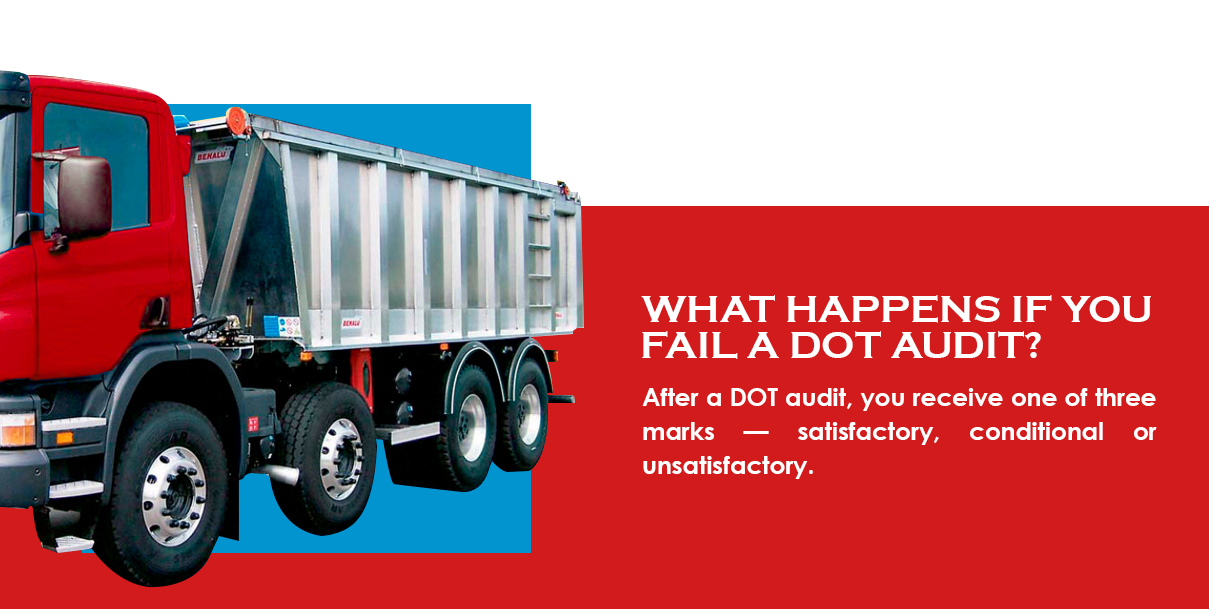
What Happens If You Fail a DOT Audit?
After a DOT audit, you receive one of three marks — satisfactory, conditional or unsatisfactory.
- A satisfactory mark does not mean you can relax. It simply means that the audit found you are following the important requirements and regulations of the DOT. However, you could be audited again if your CSA score goes up, you receive an unusual number of customer complaints, or one of your vehicles is involved in a high-profile crash.
- A conditional mark means that the auditor believes that your company may have had a violation in some part of the audit but is not deemed a safety risk. This could result in dot audit fines and increase costs for things like insurance coverage. It is possible, however, to file a Safety Management Plan and bring yourself from conditional back to satisfactory.
- An unsatisfactory rating is a problem. It means the DOT auditor found serious violations or that you were not complying with federal safety regulations. It will almost certainly result in fines. If the situation is serious, it may result in your business being designated “out of service.” If you receive an unsatisfactory rating, you can still submit a Safety Management Plan. You have 45 days to submit a plan if you are a passenger or hazmat business, and 60 days if you operate a different CMV business. The FMCSA will accept your plan or designate your company out of service.
Let American Carrier Services Help You With All Your DOT and FMSCA Regulations
As a CMV owner, you know hard it is to keep up with all of the required compliance paperwork and documentation that’s needed to prepare for a DOT audit. Not only do you have to stay on top of any changes, but you also have to make sure that your paperwork is complete and filed on time. Even a simple mistake in one or two areas can result in a conditional or unsatisfactory rating after an audit. And you need to run your business at the same time.
At American Carrier Services, we can help you. We monitor all DOT and FMCSA compliance. With our assistance, your company can implement the systems you need to run a successful CMV company. Become more organized and safer, which will give you more time to focus on your customers.
If you want to find out what American Carrier Services can do for your company, call us at (208)-214-4708 or leave your information on our contact us page and one of the members of our team will get back to you as soon as possible.

